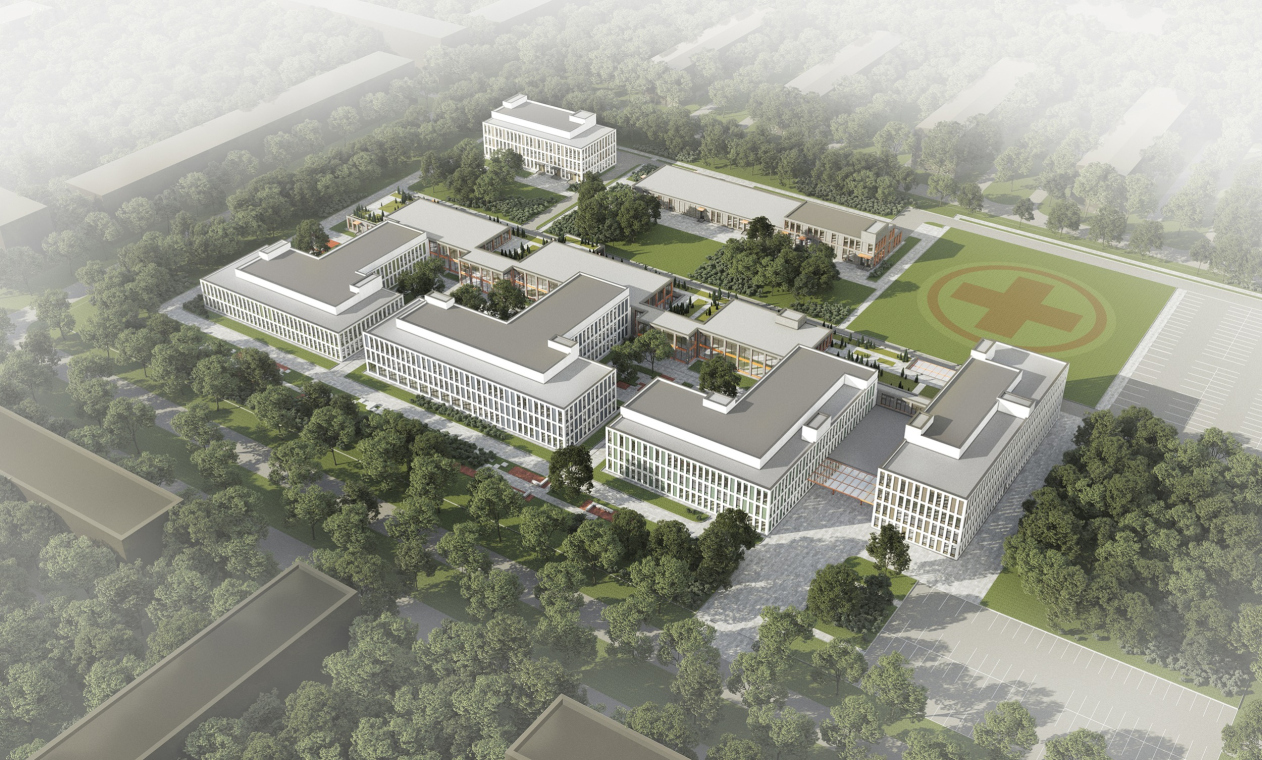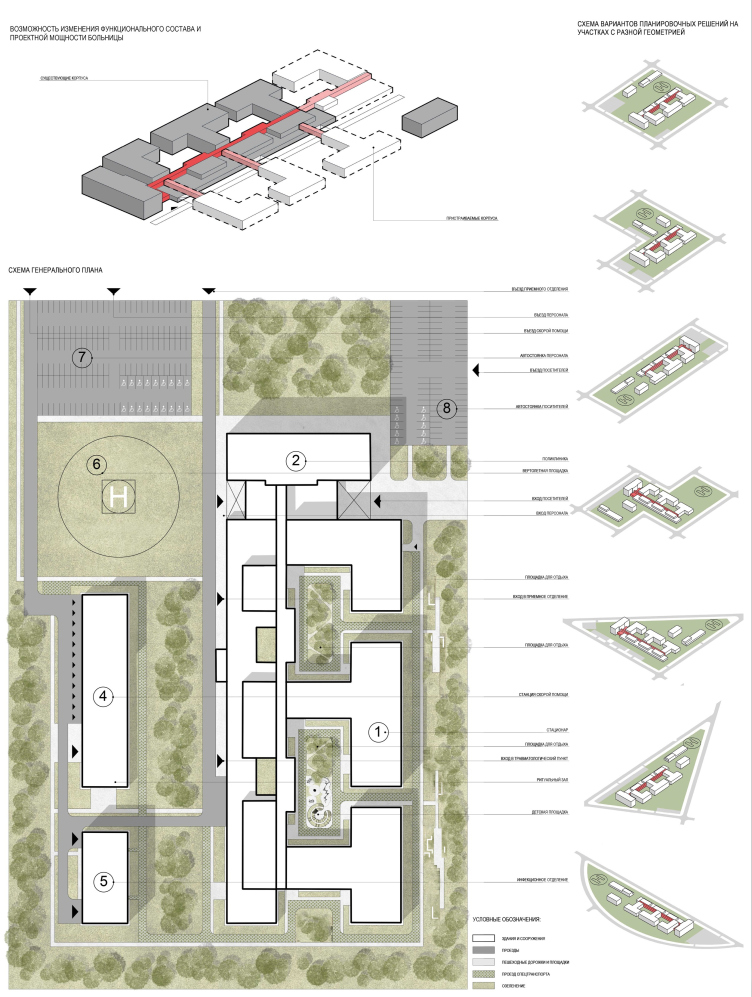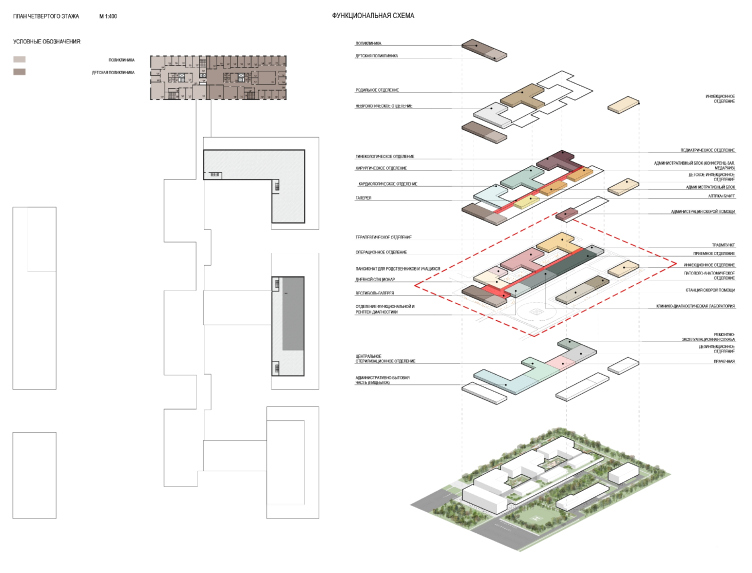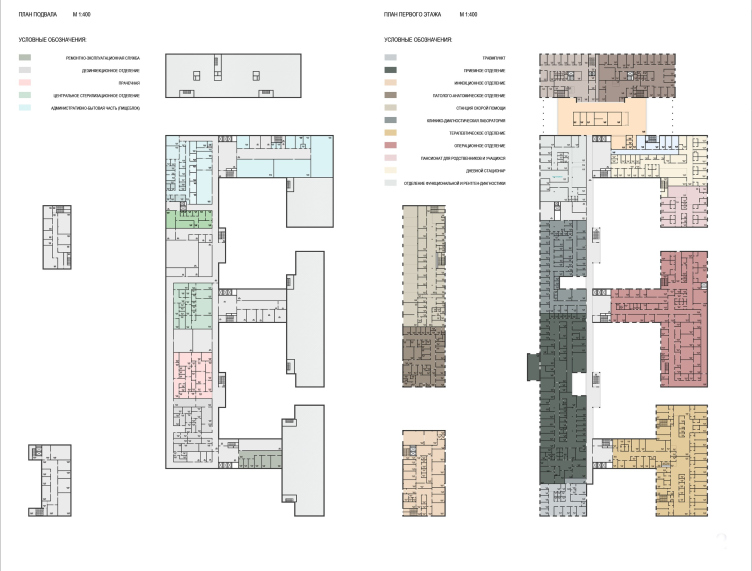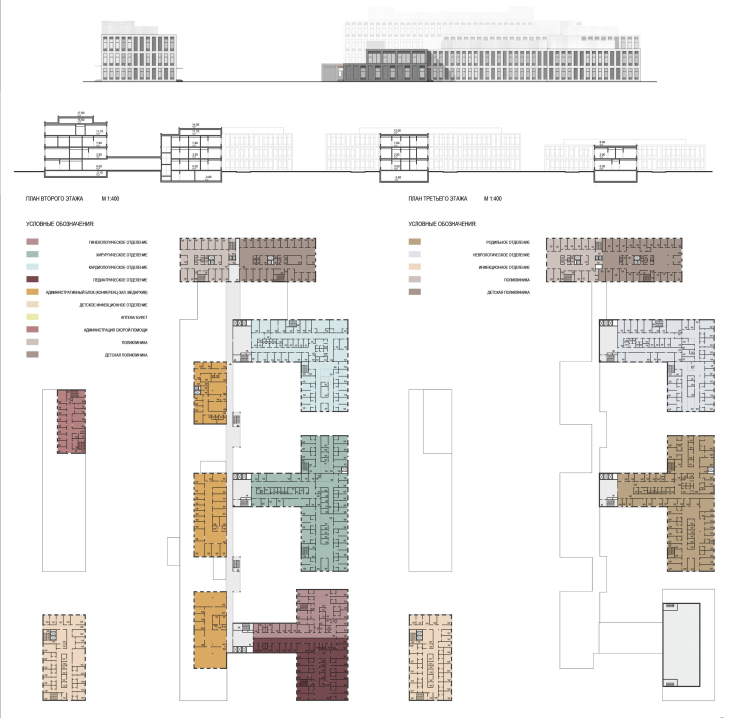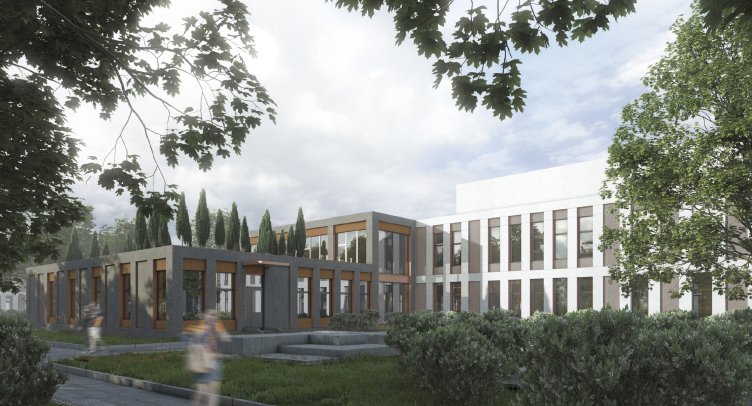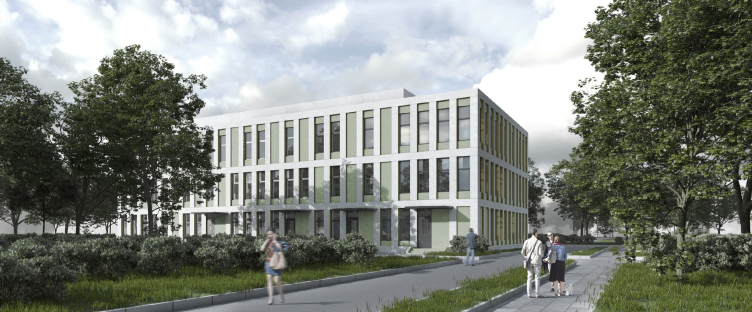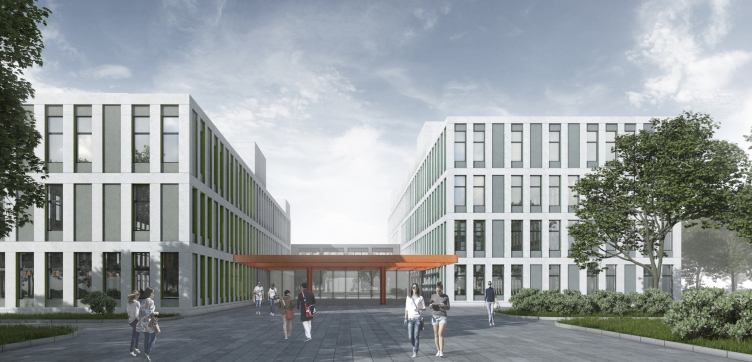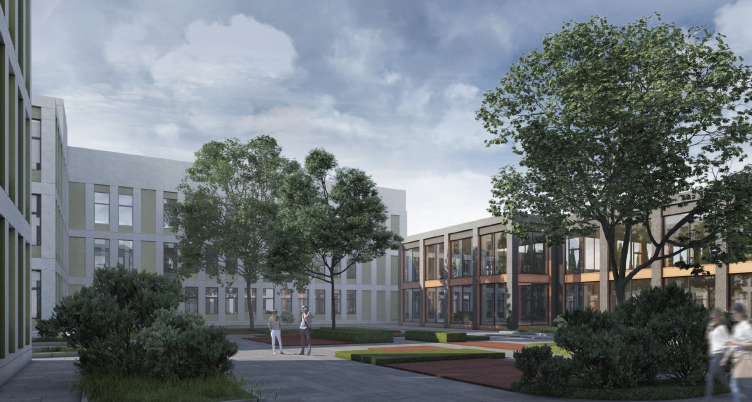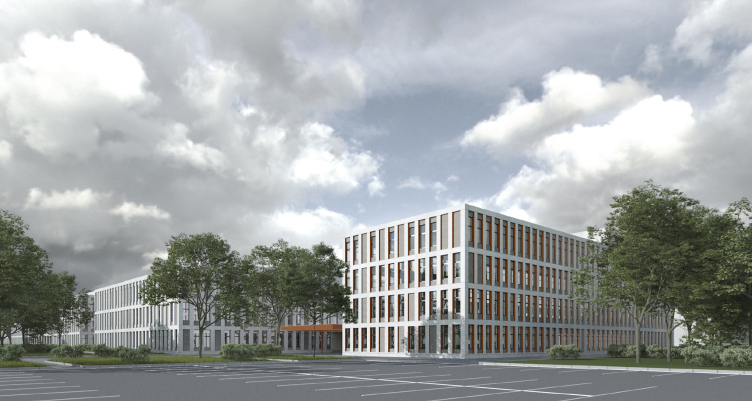First of all, the competitors were to design the clinic’s process flow diagram in a fundamentally different key than the mono-block structure type that has become widespread over the recent decades. A modern central district clinic is essentially a small town that includes a whole complex of medical facilities – an outpatient clinic, a hospital, an infectious diseases department, and an ambulance station. It is still a single building, yet it is a system of poly-blocks with a limited number of floors. Such interpretation reflects modern requirements having to do both with the traditional medical and engineering hospital equipment, and with the speedy development of technology, hence, the treatment and diagnosis facilities must not only be expandable but also require new organization of the engineering equipment. Another important factor is the humanistic message of such space, focused on the patients.
Regional hospital for 240 beds
Copyright: © Ginzburg Architects
In the concept developed by Ginzburg Architects, such poly-structure unfolds on the land site, becoming an orthogonal composition of five major blocks – three treatment ones, a management and diagnosis one, and an outpatient’s clinic for children and adults. They develop on both sides of the inner linking gallery with a common lobby for all of the units – it acts like a core that organizes all the volumes on the land site. The lobby entrance is situated on the side end – from the side of the outpatient’s clinics – and is moved closer to the entrance areas, eliminating the conflict of flows of patients and employees of various departments. The first floor of the gallery is designed to ensure the connection between the clinic’s departments; the nuclei of the vertical communications also exit here – the staircase and elevator halls of the ward units, and the one for the visitors, the management, and the students.
Regional hospital for 240 beds
Copyright: © Ginzburg Architects
Regional hospital for 240 beds
Copyright: © Ginzburg Architects
The compact, yet at the same time flexible, structure of the blocks meets the two most important requirements for the modern Central District Clinic – to organize simple and convenient connections between the departments, and provide clear functional zoning, based on the specifics of treatment processes, and, hence, with equipping these or those blocks with specialized equipment. At the same time, the flexibility of the proposed structure makes it possible to change the clinics’ specialization in response to the specific needs of a particular area, and organize them proceeding not from concrete functions of individual departments but from the needs of the medical process in its entirety, where every component of the complex plays a part.
Regional hospital for 240 beds
Copyright: © Ginzburg Architects
For example, the slab of the management and diagnosis block is stretched along the gallery, which establishes a convenient connection between the receiving and diagnosis departments. The operation, surgical, maternity, and cardiology departments are placed near one another in such a way that, should such a necessity arise, the intensive care wards could be activated for any patients from these departments. The functional diagnosis department and the laboratories are situated closer to the block of the outpatients’ clinics, and are linked by an overpass on the second-floor level, this overpass also accessible to the hospitals.
Regional hospital for 240 beds
Copyright: © Ginzburg Architects
The ward blocks are situated on the opposite side from the entrances to the receiving department, forming semi-closed yards – the windows of the wards exit here. This way, they will be turned in the direction of the park territory and separated from all the noise sources, as well as from the loading bay, and the патологоанатомического корпуса by an elongated building with the receiving department. To provide for the patients’ relatives, as well as the medical students, the architects designed a small hotel on the first floor with an individual entrance.
Regional hospital for 240 beds
Copyright: © Ginzburg Architects
The arrangement of the blocks along the main gallery axis makes it possible to freely change their number, as well as the sizes and the functions of the blocks. In addition, the structure can be efficiently “rearranged” and “mounted” on rather complex land sites in dense urban construction conditions. The presence of the central gallery in any of the options will ensure convenient technological connections between the departments.
As was already noted, the substantial transformation of the modern clinics is driven, in addition to the technological needs, by the general trend towards a more humanistic interpretation of the function. A special role is given to the ergonomics and comfort of the created space, its ability to adapt itself to patients and medical personnel, and mitigating the inevitably stressful situation by design techniques. The very fact that the number of floors of hospital buildings has been growing ever smaller, reaching the human-friendly size that is on a level with, or even lower than the treetops, is proof that an important step is made toward the new image.
Regional hospital for 240 beds
Copyright: © Ginzburg Architects
The merger of architecture and landscape, as well as the extended tree planting program go a long way to create a positive image of hospitals. In the concept developed by Ginzburg Architects, it is represented by the parkland area from the side of the ward units, which ensures the patients’ privacy, by the trees that are planted in the inner semi-closed yards with lawns, and by the green slideways for the separately standing infection and anatomico-pathological departments. It is planned to make the flat roofs of the units green as well – considering the low-rise character and the predominantly horizontal character of the structures, such spaces are rather numerous, and they are quite viewable from the windows of the wards and offices.
Regional hospital for 240 beds
Copyright: © Ginzburg Architects
Another thing that gets revised is the approach towards designing the public spaces of the clinics, such as lobbies. Connected to the lobby, the gallery in this case realizes the typology of an inner street. Furthermore, it gets the typical city services, such as cafe zones, bank offices, phone shops, and stores, whose presence helps both patients and personnel to get rid of the isolation feeling that inevitably develops behind the inevitable hospital fence.
Regional hospital for 240 beds
Copyright: © Ginzburg Architects
The design solution of the facades combines the principle of human-friendly proportions with an industrial construction method. The facade grid itself is universal here – the project provides a ventilation facade with a top layer of slab material. The design solutions provide for maximum possible unification of construction spans, window sizes, stained glass windows, and the facade elements. At the same time, one can vary the rhythm and the accents, observing the layers of the joints, as well as the arrangement of the entrance groups, starting from the ground level. The volume of the gallery, which forms the space of the inner yards, is designed – by contrast with the main facades – as being lighter and more transparent.
Regional hospital for 240 beds
Copyright: © Ginzburg Architects
The concept by Ginzburg Architects fully reflects the transformations that the Russian clinics are currently going through, following the revolution in designing the medical function that happened in Europe and the USA a few decades earlier. Clinics and hospitals are generally becoming less numerous, yet they are growing considerably bigger in size because large-scale investment into medical technologies naturally leads to what can be called “concentration of procedures'' and integration of functions, including research and development. A typical Central District Clinic combines many subdivisions into complex poly-structures, one of the most important factors for which is flexibility and comprehensiveness of inner links, as well as reliable and continuous functioning of numerous processes. At the same time, the function gets a fundamentally different wrap-up: it’s technological quality is inseparable from the quality of its physical surroundings, whose influence on the patients’ and personnel’s well-being is hard to overestimate.
Regional hospital for 240 beds
Copyright: © Ginzburg Architects

